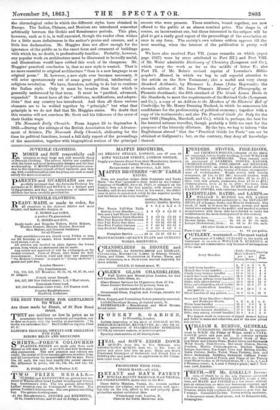The Course and Current of Architecture. By Samuel Huggins, archi-
tect. (John Weale ; Day and Son.)—Mr. Huggins traces the progress of architecture by "a disposition of the styles," which is a "compromise between the chronological and geographical, and, as he thinks, the best possible for their relationship and mutual influence being understood." This means that he begins with the Egyptian, Assyrian, Persian, and kindred styles. Then he treats of the Greek, and thenceforth follows
the chronological order in which the different styles have obtained. in Europe. The Indian, Chinese, and Mexican are introduced somewhat arbitrarily between the Gothic and Renaissance periods. This plan, however, such as it is, is well executed, though the reader often wishes for a little more definiteness in the author's praise and censure, and a little less declamation. Mr. Huggins does not allow enough for the ignorance of the public as to the exact form and ornament of buildings with which he, no doubt, is professionally familiar. Probably, however, any popular work on architecture must be illustrated to be really useful, and illustrations would have robbed this work of its cheapness. Mr. Huggins' practical conclusion is, that no new style is wanted. That is no more essential to original architecture "than is a new language to an original poem." If, however, a new style ever becomes necessary, it will arise spontaneously out of some great political, intellectual, or religions revolution. We have, therefore, nothing to do but to continue the Italian style. Only it must be broader than that which is generally understood by that term. It must be "purified, advanced, expanded." It must have all the "additions, modifications, and adapta- tions" that any country has introduced. And then all these various elements are to be welded together by "principle," but what that principle is we do not find that Mr. Huggins states. We doubt that this treatise will not convince Mr. Scott and his followers of the error of their Gothic ways.































 Previous page
Previous page